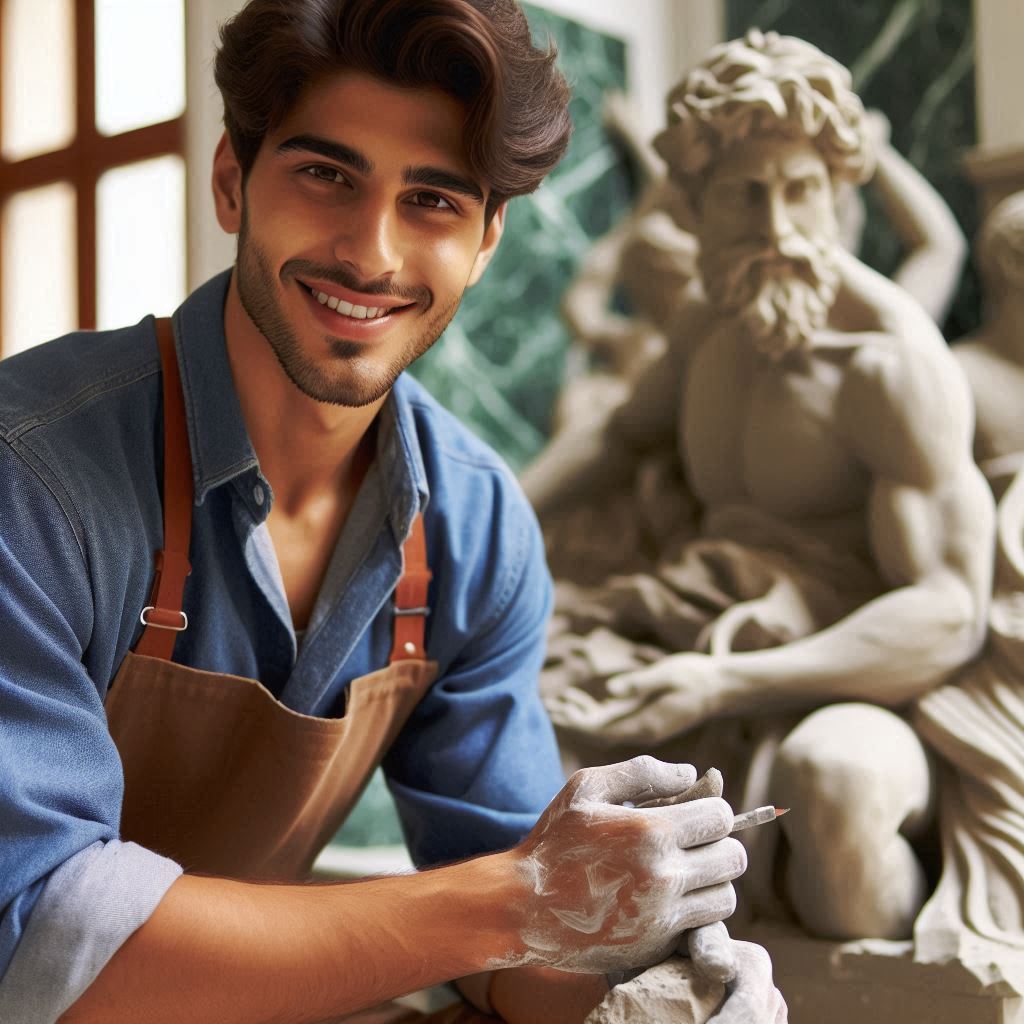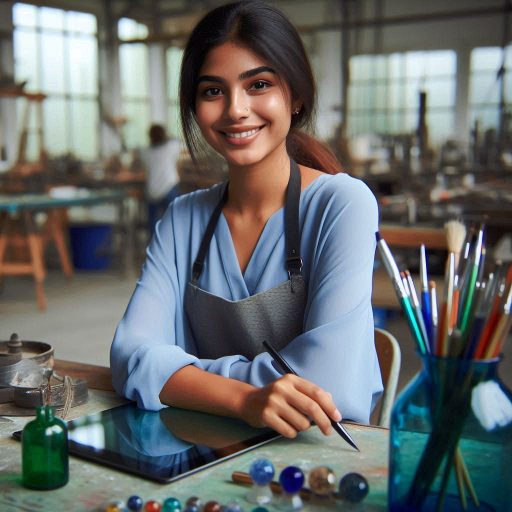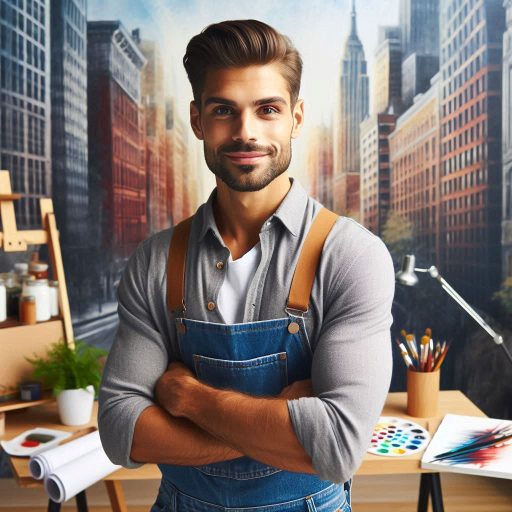Introduction
Art and design collaborations have become increasingly popular in the creative industry.
These partnerships bring together diverse talents and perspectives to create innovative and impactful work.
Collaborations in art and design are essential for pushing boundaries, exploring new ideas, and reaching a broader audience.
This trend has gained momentum as artists and designers recognize the power of working together.
The purpose of this blog post is to examine the benefits and challenges of art and design collaborations.
By delving into these aspects, we aim to provide insights for both creators and audiences on the dynamics of collaborative projects.
Benefits of Art and Design Collaborations
Increased creativity and innovation through different perspectives
Collaborating in the realm of art and design offers a multitude of benefits that can help individuals and organizations alike.
One of the key advantages is the increased creativity and innovation that comes from working with individuals who bring different perspectives to the table.
When artists and designers collaborate, they can push the boundaries of traditional thinking and come up with new and innovative ideas that they may not have thought of on their own.
Opportunity to reach new audiences and markets
Furthermore, art and design collaborations provide the opportunity to reach new audiences and markets.
By partnering with other creatives, artists and designers can tap into different networks and introduce their work to a broader audience.
This can lead to increased exposure and potentially open up new opportunities for growth and expansion.
Sharing of resources and skills to achieve a common goal
Another benefit of collaborating in the world of art and design is the sharing of resources and skills.
By pooling together their talents and expertise, collaborators can leverage each other’s strengths to achieve a common goal.
This can result in more efficient and effective outcomes, as well as a sense of camaraderie and teamwork among the collaborators.
Building stronger relationships within the creative community
Additionally, art and design collaborations can help in building stronger relationships within the creative community.
By working together on projects and sharing experiences, artists and designers can forge connections that can lead to future collaborations and partnerships.
These relationships can be invaluable in the competitive and fast-paced world of art and design, as they can provide support, inspiration, and opportunities for growth.
Overall, art and design collaborations offer a host of benefits that can enhance creativity, expand reach, facilitate resource-sharing, and strengthen relationships within the creative community.
By embracing collaboration, artists and designers can unlock new possibilities and achieve greater success in their respective fields.
Transform Your Career Today
Unlock a personalized career strategy that drives real results. Get tailored advice and a roadmap designed just for you.
Start NowRead: Essential Tools for Mural Painting and Design
Challenges of Art and Design Collaborations
When artists and designers come together to collaborate, they often face a myriad of challenges that can impact the success of their partnership.
These challenges include:
Potential conflicts in creative vision and decision-making
One of the primary challenges in art and design collaborations is the presence of potential conflicts in creative vision and decision-making.
Artists and designers may have differing perspectives on how a project should be executed, leading to disagreements that can hinder progress and compromise the final outcome.
Communication barriers between collaborators
Furthermore, communication barriers between collaborators can also impede the success of a collaboration.
Misunderstandings, lack of clarity, and poor communication can result in delays, errors, and frustration among team members.
Differences in working styles and processes
Another common challenge is the differences in working styles and processes among collaborators.
Artists and designers may have unique approaches to their craft, which can clash when trying to work together on a project.
Finding a compromise that accommodates everyone’s methods can be difficult.
Balancing individual egos and priorities
Additionally, balancing individual egos and priorities can pose a challenge in art and design collaborations.
Each collaborator may have their own agenda, personal preferences, and ambitions, which can lead to conflicts of interest and competition within the team.
Overcoming these challenges requires open and honest communication, mutual respect, flexibility, and a shared commitment to the project’s success.
Collaborators must be willing to compromise, listen to each other’s perspectives, and find common ground to make the collaboration work.
By recognizing and addressing these challenges upfront, artists and designers can navigate the complexities of collaboration more effectively and leverage the diversity of skills and talents within the team to create innovative and impactful work.
Read: The Future of Sculpture in the Digital Age
Successful Examples of Art and Design Collaborations
Case Studies of Successful Art and Design Collaborations
The collaboration between Nike and artist Virgil Abloh resulted in innovative shoe designs.
Apple’s collaboration with designer Jony Ive led to groundbreaking product aesthetics.
The partnership between Louis Vuitton and artist Yayoi Kusama created stylish fashion pieces.
Showcase Your Business Today
Reach thousands of readers actively exploring professional services. Publish your business profile and grow your audience now.
Publish NowAdidas’s collaboration with musician Kanye West produced highly coveted sneaker collections.
Key Factors That Contributed to Success
- Clear communication between the artists and designers involved in the collaboration.
- Mutual respect for each other’s expertise and creative vision.
- Shared goals and objectives to guide the direction of the collaboration.
- Openness to new ideas and willingness to experiment with unconventional approaches.
Impact of Successful Collaborations
- Increased brand visibility and recognition for both parties.
- Enhanced creativity and innovation due to cross-pollination of ideas.
- Access to new markets and audiences through combined fan bases.
- Elevated status within the industry as trendsetters and thought leaders.
Inspiration for Readers
- Encourage readers to seek out potential collaborators with complementary skills.
- Emphasize the value of collaboration in pushing creative boundaries.
- Highlight the benefits of sharing resources and expertise for mutual growth.
- Motivate readers to embrace collaboration as a strategic tool for success.
Read: Networking Tips for Art and Design Professionals

Tips for Navigating Art and Design Collaborations
Establish clear goals and expectations from the beginning
- Define the purpose of the collaboration to avoid misunderstandings later on.
- Ensure all parties involved are aligned in terms of objectives and outcomes.
- Set measurable goals to track progress and success throughout the collaboration.
Communicate openly and regularly with collaborators
- Foster a transparent and inclusive communication environment.
- Share updates, challenges, and ideas to keep everyone on the same page.
- Encourage feedback and active participation from all team members.
Be open to compromise and feedback from others
- Embrace different perspectives and be willing to adapt your approach.
- Collaborate with humility and respect for each other’s ideas.
- Use feedback as an opportunity for growth and improvement in the collaboration.
Set aside time for reflection and evaluation after the collaboration
- Reflect on the overall process, challenges faced, and achievements made.
- Evaluate the effectiveness of the collaboration in achieving its goals.
- Identify areas for improvement and learnings to carry forward into future collaborations.
By following these tips, artists and designers can navigate collaborations effectively, maximize creativity and innovation, and build successful partnerships in their work.
Read: Famous American Muralists and Their Iconic Works
Delve into the Subject: Breaking into the Film Industry as a Concept Artist
See Related Content: How to Stay Creative in a Web Design Career
Potential Opportunities for Future Collaborations
Emerging trends in collaborative art and design projects
Collaborative art and design projects are constantly evolving, and it is crucial to stay updated on the current trends.
By discussing emerging trends, individuals can gain insights into new ways of working together to create innovative and impactful pieces.
New technologies and platforms enabling collaborations
Technology is playing a significant role in facilitating collaborations in the art and design industry.
From virtual reality tools to online platforms, there are various resources available to artists and designers to collaborate effectively regardless of their physical location.
Encouragement to seek out new opportunities for collaboration in their own work
Encouraging readers to actively seek out new opportunities for collaboration in their own work can lead to valuable connections and creative growth.
By stepping outside of their comfort zones, artists and designers can discover new perspectives and techniques that can enhance their work.
Importance of continuous learning and adaptation in the creative industry
Continuous learning and adaptation are essential in the creative industry, where trends and technologies are constantly changing.
Emphasizing the importance of staying updated and being open to new ideas can help individuals stay relevant and competitive in the market.
Overall, embracing collaboration in art and design not only fosters creativity and innovation but also opens up a world of opportunities for growth and development.
By being proactive in seeking out new collaborations and staying informed about emerging trends, individuals can make significant strides in their creative careers.
Gain More Insights: How to Build a Strong Portfolio in Web Design
Uncover the Details: Effective UX/UI Design Strategies for Mobile Apps
Conclusion
Art and design collaborations offer numerous benefits to creators.
Collaboration allows for diverse perspectives, leading to innovative and creative outcomes.
By working together, artists and designers can push boundaries and explore new ideas that they may not have considered individually.
Despite the challenges that may arise, the rewards of collaboration – such as learning from others, expanding skills, and gaining exposure – make it worthwhile.
Having a supportive team can help in overcoming obstacles and generate solutions that one might not have arrived at alone.
In essence, embracing art and design collaborations is essential for fostering creativity and driving innovation in the creative industry.
To all the readers, I encourage you to seek out opportunities for collaboration, as it can be a transformative experience that enriches your practice and opens up new possibilities.
Let’s continue to collaborate, inspire each other, and push the boundaries of what is possible in art and design.
Together, we can achieve greatness and make a lasting impact in the creative world.
[E-Books for Sale]
The Big Book of 500 High-Paying Jobs in America: Unlock Your Earning Potential
$19.99 • 500 High-Paying Jobs • 330 pages
Explore 500 high-paying jobs in America and learn how to boost your career, earn more, and achieve success!
See All 500 High-Paying Jobs of this E-Book
1001 Professions Without a Degree: High-Paying American Jobs You Can Start Now
$19.99 • 1001 Professions Without a Degree • 174 pages
Discover 1001 high-paying jobs without a degree! Unlock career tips, skills, and success strategies for just $19.99!




